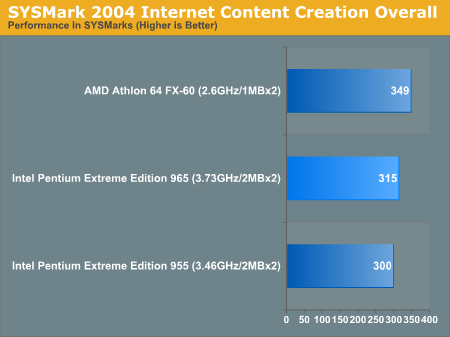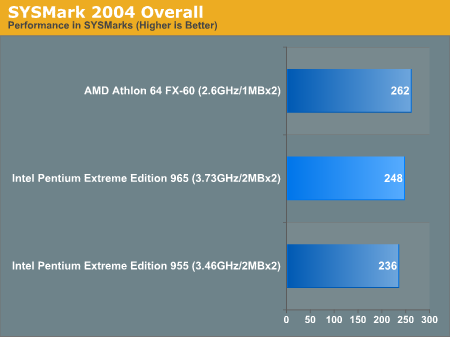Intel's Pentium Extreme Edition 965: The Last of a Dying Breed
by Anand Lal Shimpi on March 22, 2006 1:51 PM EST- Posted in
- CPUs
Overall Performance using SYSMark 2004
Office Productivity SYSMark 2004
SYSMark's Office Productivity suite consists of three tests, the first of which is the Communication test. The Communication test consists of the following:
ICC SYSMark 2004
The first category that we will deal with is 3D Content Creation. The tests that make up this benchmark are described below:
Office Productivity SYSMark 2004
SYSMark's Office Productivity suite consists of three tests, the first of which is the Communication test. The Communication test consists of the following:
"The user receives an email in Outlook 2002 that contains a collection of documents in a zip file. The user reviews his email and updates his calendar while VirusScan 7.0 scans the system. The corporate web site is viewed in Internet Explorer 6.0. Finally, Internet Explorer is used to look at samples of the web pages and documents created during the scenario."The next test is Document Creation performance:
"The user edits the document using Word 2002. He transcribes an audio file into a document using Dragon NaturallySpeaking 6. Once the document has all the necessary pieces in place, the user changes it into a portable format for easy and secure distribution using Acrobat 5.0.5. The user creates a marketing presentation in PowerPoint 2002 and adds elements to a slide show template."The final test in our Office Productivity suite is Data Analysis, which BAPCo describes as:
"The user opens a database using Access 2002 and runs some queries. A collection of documents are archived using WinZip 8.1. The queries' results are imported into a spreadsheet using Excel 2002 and are used to generate graphical charts."

ICC SYSMark 2004
The first category that we will deal with is 3D Content Creation. The tests that make up this benchmark are described below:
"The user renders a 3D model to a bitmap using 3ds max 5.1, while preparing web pages in Dreamweaver MX. Then the user renders a 3D animation in a vector graphics format."Next, we have 2D Content Creation performance:
"The user uses Premiere 6.5 to create a movie from several raw input movie cuts and sound cuts and starts exporting it. While waiting on this operation, the user imports the rendered image into Photoshop 7.01, modifies it and saves the results. Once the movie is assembled, the user edits it and creates special effects using After Effects 5.5."The Internet Content Creation suite is rounded up with a Web Publishing performance test:
"The user extracts content from an archive using WinZip 8.1. Meanwhile, he uses Flash MX to open the exported 3D vector graphics file. He modifies it by including other pictures and optimizes it for faster animation. The final movie with the special effects is then compressed using Windows Media Encoder 9 series in a format that can be broadcast over broadband Internet. The web site is given the final touches in Dreamweaver MX and the system is scanned by VirusScan 7.0."












41 Comments
View All Comments
whitelight - Wednesday, March 22, 2006 - link
what cpu do you think it is? an opty 144?
swtethan - Wednesday, March 22, 2006 - link
P-D 805 probablypnyffeler - Wednesday, March 22, 2006 - link
I've always been a huge supporter of AMD, but parts of me get all tingly when I think of Conroe on the horizon.Talk about switching teams...
Googer - Thursday, March 23, 2006 - link
AMD could possibly be more competitive with a 4 MB cache instead of 2MB the Current Athlon 64 has. It may or may not help much but conroe also has a 60MHz advantege over A64.BrownTown - Wednesday, March 22, 2006 - link
Can we get some HT disabled tests, the replay bug really messes with these chips performance in some apps, would be nice to see how disabling HT would help in some apps. Its usually like a 50:50 split, so if you have a specific use then there is a good possibility you will likely get better performance than these benchmarks suggest in certain apps.allometry - Wednesday, March 22, 2006 - link
I don't think there is anything wrong with how you feel about AMD and Intel. I think the majority of geeks have been used to rooting for the underdog, AMD, for the past couple years. AMD was cranking out superior chips in comparison to Intel's.But now, Intel is back as the powerhouse we once knew. This is competition and it is what we should have all been rooting for instead of just the underdog. Sure, it's easy to get wrapped up in the benchmarks and post ubsurd comments such as, "AMD is t3h pwnz0rz0x0x!!11", but now, it's time to be realistic and say that Intel's back with something that isn't the suck.
I'm happy with my AMD setup and in the future, if money presents itself, Intel may once again have a place in my pocket book. Let's just hope that AMD comes back with something competitive to Conroe!
Regs - Wednesday, March 22, 2006 - link
The Power house we once new stood by itself with a P3 that ran quake and ms excel with the help of 3DfX voodoo. When did Intel ever have the lead in 3D games? Before the K8? This was...8 years ago? This is exactly why people route for the "underdog". As far as im concerned, AMD has always been the superior technology for gaming and overall efficiency no matter what Intel said or threw at it. We have finally reached a new cycle for processing, visual effects, and programming. AEGIA's physics processor concept, Windows Vista, Intel's conroe, AMD's new born, and DX9/DX10 gaming are right around the corner. Yes, exciting times are ahead.defter - Thursday, March 23, 2006 - link
Athlon64 was released 2.5 years ago...
MrKaz - Thursday, March 23, 2006 - link
Have you hear of Athlon, then Athlon XP, ... and it wasnt 2.5 years ago...SUNNYVALE, CA -- January 31, 2003 --AMD (NYSE:AMD) today announced that the worldwide introduction of its next-generation, 64-bit AMD Opteron™ processor for servers and workstations will take place on April 22 in New York City. AMD plans to follow up with the introduction of the AMD Athlon™ 64 processor for the desktop and mobile markets in September 2003.
The first Athlon (the P3 killer and the more recent P4 killer) was released in June 23, 1999.
LoneWolf15 - Thursday, March 23, 2006 - link
The Athlon and Athlon XP were K7 chips, not K8. Therefore, the reply makes sense.